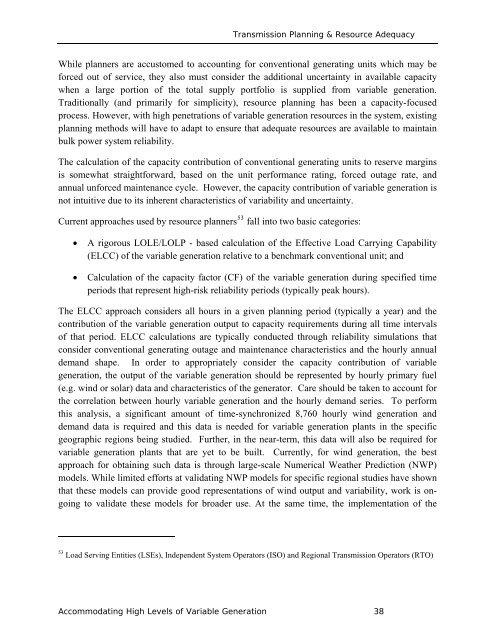Accommodating High Levels of Variable Generation - NERC
Accommodating High Levels of Variable Generation - NERC
Accommodating High Levels of Variable Generation - NERC
Create successful ePaper yourself
Turn your PDF publications into a flip-book with our unique Google optimized e-Paper software.
Transmission Planning & Resource Adequacy<br />
While planners are accustomed to accounting for conventional generating units which may be<br />
forced out <strong>of</strong> service, they also must consider the additional uncertainty in available capacity<br />
when a large portion <strong>of</strong> the total supply portfolio is supplied from variable generation.<br />
Traditionally (and primarily for simplicity), resource planning has been a capacity-focused<br />
process. However, with high penetrations <strong>of</strong> variable generation resources in the system, existing<br />
planning methods will have to adapt to ensure that adequate resources are available to maintain<br />
bulk power system reliability.<br />
The calculation <strong>of</strong> the capacity contribution <strong>of</strong> conventional generating units to reserve margins<br />
is somewhat straightforward, based on the unit performance rating, forced outage rate, and<br />
annual unforced maintenance cycle. However, the capacity contribution <strong>of</strong> variable generation is<br />
not intuitive due to its inherent characteristics <strong>of</strong> variability and uncertainty.<br />
Current approaches used by resource planners 53 fall into two basic categories:<br />
• A rigorous LOLE/LOLP - based calculation <strong>of</strong> the Effective Load Carrying Capability<br />
(ELCC) <strong>of</strong> the variable generation relative to a benchmark conventional unit; and<br />
• Calculation <strong>of</strong> the capacity factor (CF) <strong>of</strong> the variable generation during specified time<br />
periods that represent high-risk reliability periods (typically peak hours).<br />
The ELCC approach considers all hours in a given planning period (typically a year) and the<br />
contribution <strong>of</strong> the variable generation output to capacity requirements during all time intervals<br />
<strong>of</strong> that period. ELCC calculations are typically conducted through reliability simulations that<br />
consider conventional generating outage and maintenance characteristics and the hourly annual<br />
demand shape. In order to appropriately consider the capacity contribution <strong>of</strong> variable<br />
generation, the output <strong>of</strong> the variable generation should be represented by hourly primary fuel<br />
(e.g. wind or solar) data and characteristics <strong>of</strong> the generator. Care should be taken to account for<br />
the correlation between hourly variable generation and the hourly demand series. To perform<br />
this analysis, a significant amount <strong>of</strong> time-synchronized 8,760 hourly wind generation and<br />
demand data is required and this data is needed for variable generation plants in the specific<br />
geographic regions being studied. Further, in the near-term, this data will also be required for<br />
variable generation plants that are yet to be built. Currently, for wind generation, the best<br />
approach for obtaining such data is through large-scale Numerical Weather Prediction (NWP)<br />
models. While limited efforts at validating NWP models for specific regional studies have shown<br />
that these models can provide good representations <strong>of</strong> wind output and variability, work is ongoing<br />
to validate these models for broader use. At the same time, the implementation <strong>of</strong> the<br />
53 Load Serving Entities (LSEs), Independent System Operators (ISO) and Regional Transmission Operators (RTO)<br />
<strong>Accommodating</strong> <strong>High</strong> <strong>Levels</strong> <strong>of</strong> <strong>Variable</strong> <strong>Generation</strong> 38
















